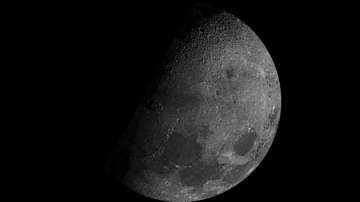Moon rusting along poles. Photo from ISRO's Chandrayaan-1 reveals
Moon is rusting. Images captured by ISRO's Chandrayaan-1 suggests the moon is rusting along the poles.

Moon is rusting. Images captured by ISRO's Chandrayaan-1 suggests the moon is rusting along the poles. The formation of rust can be attributed to the presence of two key elements -- water and oxygen when in contact with iron. Scientists propose that fast-moving dust particles might initiate the release of surface borne water molecules, thus allowing water to mix with iron.
It is believed that though Moon lacks atmosphere to support the formation of oxygen, it hosts traces of oxygen that travels from Earth to reach the lunar environment.
Earlier on Monday, India's Union Minister Jitendra Singh on Sunday said that the images sent by India's first lunar mission, Chandrayaan-1, suggest that the Moon may be rusting along the poles. Chandrayaan-1 was launched in 2008. ISRO's maiden mission to the Moon has sent images that show that the Moon may be rusting along the poles.
“The sign of this finding is that even though the surface of the Moon is known to have iron-rich rocks, it is not known for the presence of water and oxygen, which are the two elements needed to interact with iron to create rust,” said Singh, who is the Minister of State for the Department of Space.
NASA on why rusting of Moon is puzzling
"While our Moon is airless, research indicates the presence of hematite, a form of rust that normally requires oxygen and water. That has scientists puzzled," NASA blog post read.
Mars has long been known for its rust. Iron on its surface, combined with water and oxygen from the ancient past, give the Red Planet its hue. But scientists were recently surprised to find evidence that our airless Moon has rust on it as well.
NASA post further says: "A new paper in Science Advances reviews data from the Indian Space Research Organization's Chandrayaan-1 orbiter, which discovered water ice and mapped out a variety of minerals while surveying the Moon's surface in 2008. Lead author Shuai Li of the University of Hawaii has studied that water extensively in data from Chandrayaan-1's Moon Mineralogy Mapper instrument, or M3, which was built by NASA's Jet Propulsion Laboratory in Southern California. Water interacts with rock to produce a diversity of minerals, and M3 detected spectra – or light reflected off surfaces – that revealed the Moon's poles had a very different composition than the rest of it."
Possible explanations of rusting of moon
First explanation: "For starters, while the Moon lacks an atmosphere, it is in fact home to trace amounts of oxygen. The source of that oxygen: our planet. Earth's magnetic field trails behind the planet like a windsock. In 2007, Japan's Kaguya orbiter discovered that oxygen from Earth's upper atmosphere can hitch a ride on this trailing magnetotail, as it's officially known, traveling the 239,000 miles (385,00 kilometers) to the Moon.
2nd Explanation: That discovery fits with data from M3, which found more hematite on the Moon's Earth-facing near side than on its far side. "This suggested that Earth's oxygen could be driving the formation of hematite," Li was quoted by NASA. The Moon has been inching away from Earth for billions of years, so it's also possible that more oxygen hopped across this rift when the two were closer in the ancient past.
Thirdly, Then there's the matter of all that hydrogen being delivered by the solar wind. As a reducer, hydrogen should prevent oxidation from occurring. But Earth's magnetotail has a mediating effect. Besides ferrying oxygen to the Moon from our home planet, it also blocks over 99% of the solar wind during certain periods of the Moon's orbit (specifically, whenever it's in the full Moon phase). That opens occasional windows during the lunar cycle when rust can form.
Click here to Read NASA's blog: The Moon Is Rusting, and Researchers Want to Know Why